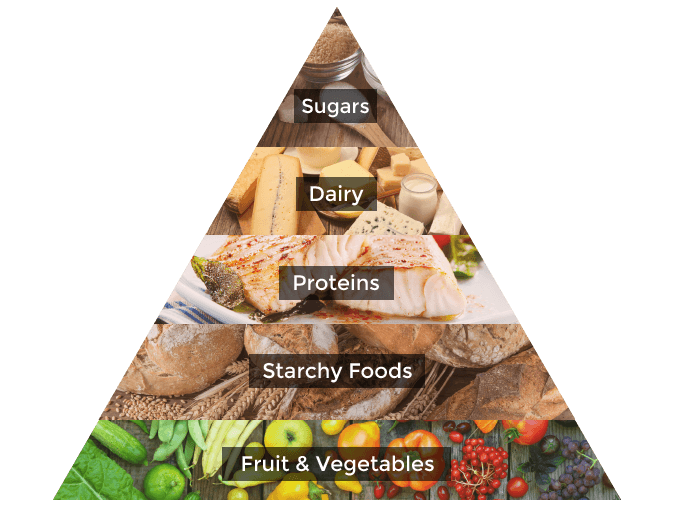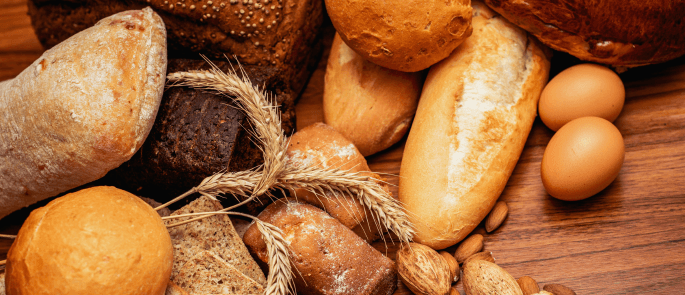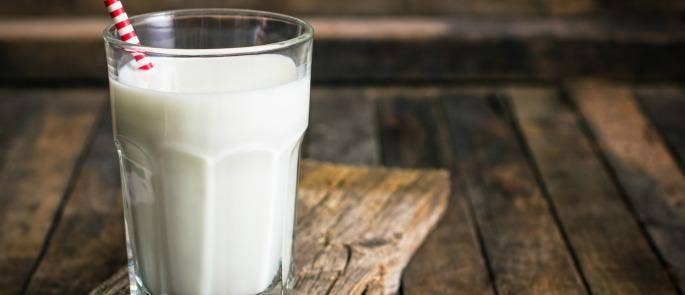The Healthy Eating Pyramid
The Healthy Eating Pyramid is a visual representation of the proportions of different foods you should be eating every day in order to maintain a healthy diet.
If each your meals are planned in proportion with the healthy eating pyramid then you are much more likely to achieve your daily requirements for vitamins, minerals, carbohydrates, proteins and essential fats.
The Healthy Eating Pyramid

The majority of the food in a healthy diet should come from the two largest sections at the base of the pyramid: fruit and vegetables and starchy foods.
The Five Layers of the Pyramid
The healthy eating pyramid is divided into layers of differing sizes representing the five common food groups, from the base upwards:
- Fruit and vegetables.
- Starchy foods, such as bread, cereals and potatoes.
- Proteins, such as meat, fish, eggs and beans.
- Milk and dairy foods.
- Fats and sugars.
The rest of this article will explore these food groups in more detail.
Need a Course?
Our Nutrition and Healthy Eating course will teach you about which foods make up a nutritious menu, the link between diet and health, and how you can effectively use the information provided by the Eatwell Guide to create a balanced diet.
1. Fruit and vegetables
Aim for at least 5 portions of fruit and vegetables each day. The key is to include a variety to ensure you get a good mix of vitamins and minerals on a daily basis. Why not see how many different colours you can fit onto your plate at each meal?
2. Starchy foods
Carbohydrates should make up the second largest portion on your plate. Choose from potatoes, rice, beans, bread, whole-grains, cous cous and pasta. The carbohydrates that these foods contain is needed by your body to create energy. Carbohydrates also help to protect your muscles, regulate blood pressure and lower cholesterol.

3. Proteins
Protein is needed by the body for building and repair. As it lies in the centre of the pyramid, you should consume a moderate amount at each meal. High quality proteins (those that are of animal origin and are easier for the body to absorb) include meat, fish, poultry, eggs and dairy products. Low quality proteins also count towards your daily intake, including grains, fruit, vegetables, peas, beans, nuts and seeds.
4. Dairy foods
Dairy is also at the centre of the food pyramid and so should be eaten in moderate amounts at every meal. Choose from a mixture of milk, cheese, yoghurt, butter, cream and any other products made using animal milk.

5. Fats and Sugars
Fats and sugars are found at the tip of the healthy eating pyramid. These are non-essential elements to a diet and so should be eaten in small amounts. Make sure that you only eat small amounts of foods such as biscuits, crisps, cakes, pastries and other processed foods, including pizzas, ready-meals and pies, as they contain a lot of calories and minimal nutritional value. Additionally, aim to avoid saturated fats (normally those from animal sources, such as butter and meat) which can raise cholesterol and be detrimental to health.
Healthy fats: fats are a source of energy and so shouldn’t be omitted from the diet completely. The trick is to separate the good fats from the bad fats. You should opt for unsaturated fats instead of saturated, such as those found in olive oil, olives, peanuts, soya beans and most vegetable oils.
What to Read Next:
- Did Your Grandparents Eat Better Than You Do?
- Healthy Eating Guide for British Teenagers
- Nutrition & Healthy Eating Quiz
- Does the Eatwell Guide Lead to a Balanced Diet?
- A Healthy Eating Plan for Fussy Eaters
- Healthy Eating Quiz for Kids
- Changes in Eating Habits Over the Years: Comparing Diets Now & Then
- The Link Between Food and Mental Health
- Nutrition Training









